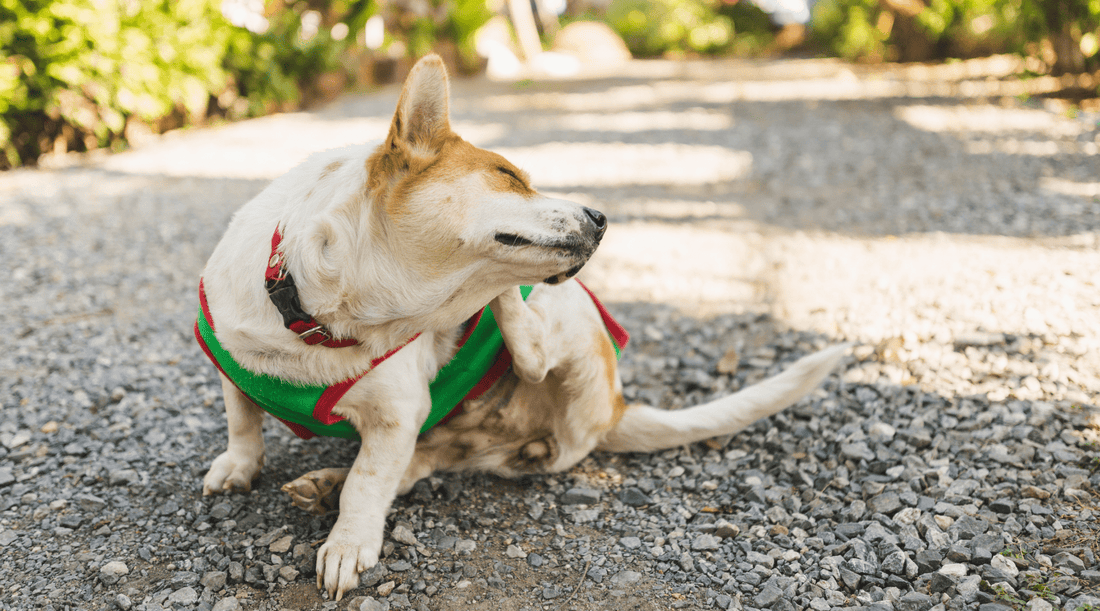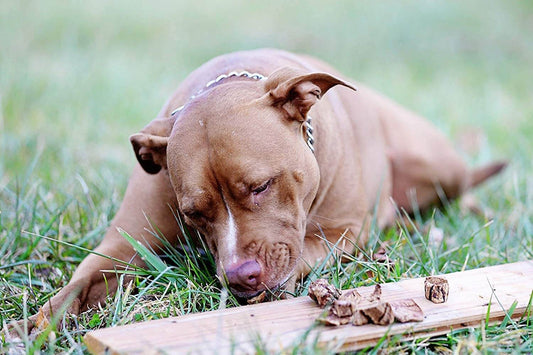
Recognizing and Treating Common Dog Skin Issues
Dawn Miller Jan 31, 20255 Minute ReadDog skin issues can arise out of nowhere. And it's not always easy to pinpoint a culprit. But the truth is that every dog deserves to be comfortable in their skin. And it's up to you and me as caring dog parents to get to the bottom of the mystery.
Last week, I ran into my neighbor Clifton at the dog-friendly coffee shop we both frequent during our early morning dog walks. He looked bleary-eyed, clutching a coffee cup like his lifeline. "Tator Tot's been scratching all night," he said, referring to his sweet little dachshund with the peculiar yet somehow befitting name. "I don’t think I’ve slept for three days straight."
I bent down to pet Tator Tot, who happily wagged her tail despite her obvious discomfort, her skin twitching as if it had a mind of its own.
Many dogs experience skin issues at some point in their lives, whether due to allergies, dryness, or more serious conditions. And when your furry friend isn’t comfortable, it’s hard to feel at ease yourself—as Clifton was finding out.
With coffee in hand, we began to discuss dog skin issues and how Clift could help his girl.
Common Signs of Skin Allergies in Dogs
- Dry, Flaky Skin, which may look like dandruff in the hair since you can't always see the skin.
- Allergy symptoms like sneezing, coughing, wheezing or watery eyes may accompany skin allergies as the whole body tries to attack perceived invaders.
- Hot Spots are moist, warm, inflamed areas on the skin. You might notice them during pet sessions or cuddles.
- Visible parasites, which would most commonly be fleas but could also be mites, ringworms, and other bugs that live off the hospitality of others.
- Skin Infections, which may also smell, are often bacterial or viral but could be caused by excessive scratching from allergies or poor skin health.
- Persistent licking or gnawing at the skin, especially on the paws or belly
- Scabs or crusty areas
- Slow-healing wounds
- Pulling away when you touch, if that's not normal.
- Hair loss, especially in patches
Common Skin Problem Causes
Your dog may have allergy triggers like pollen, fleas, detergents, or bedding materials. And you should certainly work to eliminate these triggers if you can.
But beyond that, it's important to realize that allergies are an overreaction of the immune system to "harmless" substances...except fleas and other parasites. I wouldn't call those harmless.
When the immune system perceives an invader, it launches histamine into the system to wash the substances with inflammation, sneezing, and heat, which can also be very itchy.
If it were a real threat, then this response would be called for. But immune systems that are overworked or undernourished can become hyperactive.
So, helping your dog's immune system more effectively manage threats, real and perceived, can promote healthy dog skin and comfort.
And one of the best ways you can do this is by improving your dog's nutrition.
Even if your vet has diagnosed your dog with a skin condition like dermatitis or chronic skin yeast infections, know that these often have a strong nutritional component you can address while following your vet's guidance.
How Nutrition Impacts Healthy Dog Skin
Let's face it: Nutrition impacts how the body works. Period. Every cell, organ, and system needs certain nutrients to work at its best. When it doesn't have them, it improvises. And you end up with overactive responses like allergies, dermatitis, and infection-prone skin.
Now, chances are your dog and mine eat veterinarian-approved kibble. And that's good. Kibble is designed to be balanced nutrition. Highly recommended!
But it's not optimal.
Unfortunately, the high heat required to make kibble sacrifices some nutrients that dogs need for healthy skin and immune function.
Omega 3 and 6
Of particular concern are the essential fatty acids, omega 3 and 6. These healthy fats are crucial for skin and immune health because they reduce inflammation (-itis) and keep immunity in balance.
Omega 3 is also critical for hydration, brain, and heart health. So, no matter what, you want to ensure your dog gets enough.
If they only eat kibble or canned food, probably not.
All-natural treats for dogs like grass-fed beef marrow dog bones contain substantial healthy fats and are lower in saturated fat than grain-fed herds.
Collagen
Collagen is a structural protein responsible for maintaining skin integrity and helping damaged skin heal. Without collagen, dogs couldn't build bones, joints, organs, vessels, or any body structure.
It's prevalent in connective tissues, skin, organ meat, and bone marrow...and not so much in kibble.
But do you know where you can get collagen for dogs?
Turn to more natural treats for dogs like grass-fed beef trachea.
The trachea is the windpipe. It's a chewy tube that's mostly collagen plus ample glucosamine and chondroitin for healthier bones and joints.
You can also let them chew on marrow-filled dog bones a few times a week to get their weekly needs met.
Hyaluronic Acid
This lesser-known nutrient has been discussed extensively recently in relation to human cosmetics and cleansers because it helps the skin retain moisture.
It's also found in natural treats for dogs like beef lung treats. These are all-natural, single-ingredient organ meat treats that I use for dog training.
They're slow-and-low-heat roasted and dried. So humans can't smell them. But dogs can't resist the scent and taste.
You can see how I use them by checking out this Free 7-Day Dog Training Challenge.
Beef lung bites are also a great source of collagen.
B Vitamins
Vitamins often get destroyed by high heat. So it's smart to supplement them with healthy dog treats and dog bones that contain a lot of B.
I'll mention B12 in particular. It's better known for its mental health and energy benefits. But it's a critical anti-inflammatory vitamin that supports healthy skin cells and moisture levels, which can improve skin health in dogs.
Vitamin E and A
These vitamins are well-known to support skin health. They're also antioxidants, so they help the body adapt to environmental stresses that can cause free radicals.
Free radicals are unstable molecules that can occur when radiation, toxins, and other attacks damage cells. Antioxidants work by giving the unstable molecule one of its electrons so it becomes stable again.
This is a restorative and rejuvenating process in the body. It can reduce the risk of out-of-control cell division (cancer).
This explains why eating antioxidant-rich foods like fruits and vegetables is so important to health.
Did you know that dogs can benefit from antioxidant-rich foods like blueberries and pumpkins?
Not only are grass-fed beef dog treats like marrow bones and lung bite rich in antioxidants, but I can refill the dog bone with peanut butter or yogurt plus an antioxidant-rich fruit or veg to further support dog nutrition.
Calcium, Zinc, and Magnesium
These are just a few skin-supporting minerals also found in healthy, all-natural beef dog treats from K9 Connoisseur.
Give Your Dog the Dog Health They Deserve
Dogs deserve to feel healthy in their own skin. When allergies and skin conditions strike, consider how nutrition can support stronger skin and better immune system function. Your dog deserves what you can give. With the right care, you can keep those tails wagging and those paws itch-free.
Available On:





